
|
|
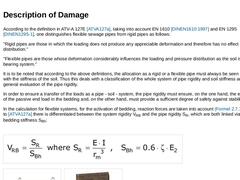
|
According to the definition in ATV-A 127E [ATVA127a], taking into account EN 1610 [DINEN1610:1997] and EN 1295 [DINEN1295-1], one distinguishes flexible sewage pipes from rigid pipes as follows: "Rigid pipes are those in which the loading does not produce any appreciable deformation and therefore has no effect on pressure distribution." "Flexible pipes are those whose deformation considerably influences the loading and pressure distribution as the … |
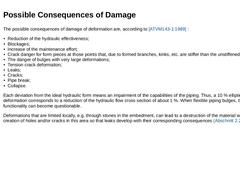
|
The possible consequences of damage of deformation are, according to [ATVM143-1:1989] : - Reduction of the hydraulic effectiveness;
- Blockages;
- Increase of the maintenance effort;
- Crack danger for form pieces at those points that, due to formed branches, kinks, etc. are stiffer than the unstiffened pipe;
- The danger of bulges with very large deformations;
- Tension crack deformation;
- Leaks;
- Cracks;
- Pipe break;
- Collapse.
Each deviation from the ideal hydraulic … |

|
|
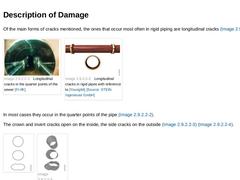
|
Of the main forms of cracks mentioned, the ones that occur most often in rigid piping are longitudinal cracks (Bild 2.8.1.1). | (Image: Longitudinal cracks in the quarter points of the sewer [FI-IfK]) | (Image: Longitudinal cracks in rigid pipes with reference to [Young84] [Image: S&P GmbH]) |
In most cases they occur in the quarter points of the pipe (Bild 2.8.1.1). The crown and invert cracks open on the inside, the side cracks on the outside (Bild 2.8.1.1) |
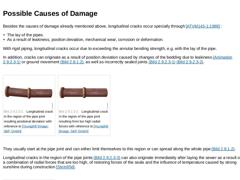
|
Besides the causes of damage already mentioned above, longitudinal cracks occur specially through [ATVM143-1:1989] : -
The lay of the pipes.
-
As a result of leakiness, position deviation, mechanical wear, corrosion or deformation.
With rigid piping, longitudinal cracks occur due to exceeding the annular bending strength, e.g. with the lay of the pipe.
In addition, cracks can originate as a result of position deviation caused by changes of the bedding … |

|
|
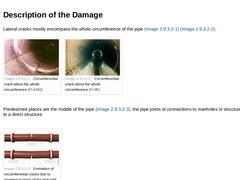
|
Lateral cracks mostly encompass the whole circumference of the pipe (Bild 2.8.2.1) (Bild 2.8.2.1). | (Image: Circumferential crack about the whole circumference [FI-KMG]) |
(Image: Circumferential crack about the whole circumference [FI-IfK]) |
Predestined places are the middle of the pipe (Bild 2.8.2.1), the pipe joints or connections to manholes or structures or transfer to a direct structure. (Image: Formation of circumferential cracks due to incorrect … |

|
|
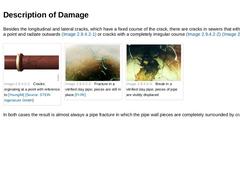
|
Besides the longitudinal and lateral cracks, which have a fixed course of the crack, there are cracks in sewers that either originate at a point and radiate outwards (Bild 2.8.3.1) or cracks with a completely irregular course (Bild 2.8.3.1) (Bild 2.8.3.1). |
(Image: Cracks orginating at a point with reference to [Young84] [Image: S&P GmbH])
|
(Image: Fracture in a vitrified clay pipe; pieces are still in place [FI-IfK])
|
(Image: Break in a vitrified … |
|

|
|
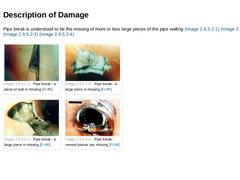
|
Pipe break is understood to be the missing of more or less large pieces of the pipe walling (Bild 2.8.4.1) (Bild 2.8.4.1) (Bild 2.8.4.1) (Bild 2.8.4.1). |
(Image: Pipe break - a piece of wall is missing [FI-IfK])
|
(Image: Pipe break - a large piece is missing [FI-IfK])
|
|
(Image: Pipe break - a large piece is missing [FI-IfK])
|
(Image: Pipe break - several pieces are missing [FI-IfK])
|
|

|
|
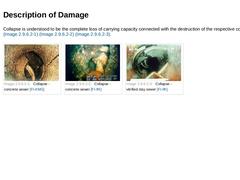
|
Collapse is understood to be the complete loss of carrying capacity connected with the destruction of the respective component (Bild 2.8.5.1) (Bild 2.8.5.1) (Bild 2.8.5.1). |
(Image: Collapse - concrete sewer [FI-KMG])
|
(Image: Collapse - concrete sewer [FI-IfK])
|
(Image: Collapse - vitrified clay sewer [FI-IfK])
|
|

|
|
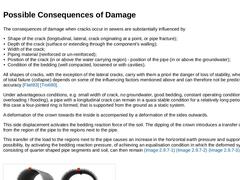
|
The consequences of damage when cracks occur in sewers are substantially influenced by - Shape of the crack (longitudinal, lateral, crack originating at a point, or pipe fracture);
- Depth of the crack (surface or extending through the component's walling);
- Width of the crack;
- Piping material (reinforced or un-reinforced);
- Position of the crack (in or above the water carrying region) - position of the pipe (in or above the groundwater);
- Condition of the …
|
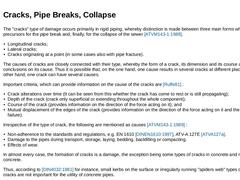
|
The "cracks" type of damage occurs primarily in rigid piping, whereby distinction is made between three main forms which can be the precursors for the pipe break and, finally, for the collapse of the sewer [ATVM143-1:1989]. - Longitudinal cracks;
- Lateral cracks;
- Cracks originating at a point (in some cases also with pipe fracture).
The causes of cracks are closely connected with their type, whereby the form of a crack, its dimension and its course allows … |

|
|
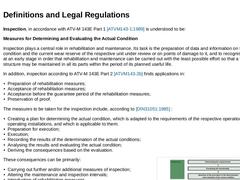
|
Inspection, in accordance with ATV-M 143E Part 1 [ATVM143-1:1989] is understood to be: Measures for Determining and Evaluating the Actual Condition Inspection plays a central role in rehabilitation and maintenance. Its task is the preparation of data and information on the actual condition and the current wear reserve of the respective unit under review or on points of damage to it, and to recognise their causes at an early stage in order that rehabilitation … |
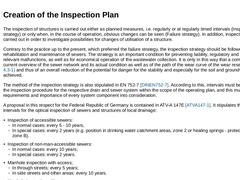
|
The inspection of structures is carried out either as planned measures, i.e. regularly or at regularly timed intervals (Inspection strategy) or only when, in the course of operation, obvious changes can be seen (Failure strategy). In addition, inspections are carried out in order to investigate possibilities for changes of utilisation of a structure. Contrary to the practice up to the present, which preferred the failure strategy, the inspection strategy … |
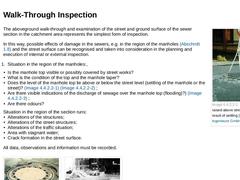
|
(Image: Manhole top raised above street level as a result of settling) The aboveground walk-through and examination of the street and ground surface of the sewer section in the catchment area represents the simplest form of inspection. In this way, possible effects of damage in the sewers, e.g. in the region of the manholes (Abschnitt 1.8) and the street surface can be recognised and taken into consideration in the planning and execution of internal … |
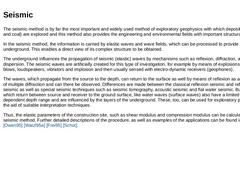
|
The seismic method is by far the most important and widely used method of exploratory geophysics with which deposits (oil, gas, and coal) are explored and this method also provides the engineering and environmental fields with important structural information. In the seismic method, the information is carried by elastic waves and wave fields, which can be processed to provide figures of the underground. This enables a direct view of its complex structure … |
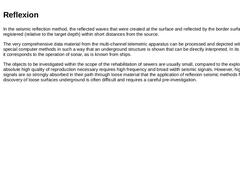
|
In the seismic reflection method, the reflected waves that were created at the surface and reflected by the border surfaces are registered (relative to the target depth) within short distances from the source. The very comprehensive data material from the multi-channel telemetric apparatus can be processed and depicted with the aid of special computer methods in such a way that an underground structure is shown that can be directly interpreted. In … |
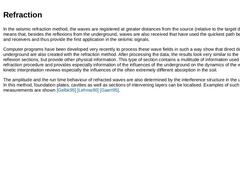
|
In the seismic refraction method, the waves are registered at greater distances from the source (relative to the target depth). This means that, besides the reflexions from the underground, waves are also received that have used the quickest path between source and receivers and thus provide the first application in the seismic signals. Computer programs have been developed very recently to process these wave fields in such a way show that direct … |
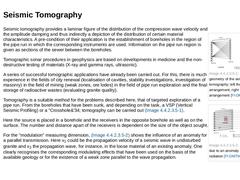
|
|
(Image: Measuring geometry of the seismic tomography; left the "crosshole" arrangement, right the "VSP" arrangement [FI-DMT98])
|
|
(Image: Delay effect due to an anomaly for a parallel radiation [FI-DMT98])
|
Seismic tomography provides a laminar figure of the distribution of the compression wave velocity and the amplitude damping and thus indirectly a depiction of the distribution of certain material characteristics. A pre-condition of their application … |